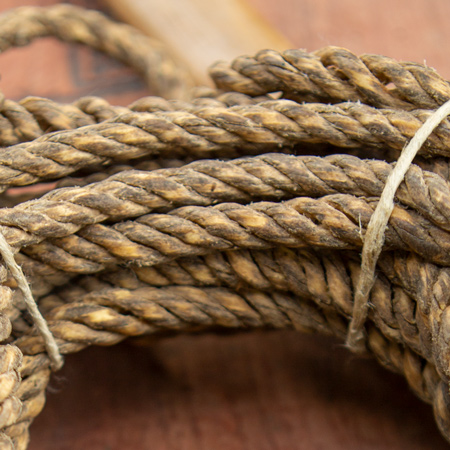At Fort Mandan, the enlisted men use log rollers, a windlass, and an elk skin rope to tow the pirogues off the riverbank. The barge is put on skids, and several Hidatsas from the Knife River Villages bring meat.
Rope Breaks
by Yellowstone Public Radio[1]Originally aired weekdays by Yellowstone Public Radio during the Bicentennial observance of 2003-2006. Narrated by Hal Hansen. Scripts by Whit Hansen and Ed Jacobson. Produced by Leni Holliman. © … Continue reading
Elk Skin Rope
Historical interpretation by John W. Fisher. Photo © 2014 by Kristopher K. Townsend. Permission to use granted under the Creative Commons Attribution-Share Alike 4.0 International license.
Skidding the Red Pirogue
all hands employed fixing the road and gitting rollers. brought up the peaces for the windless and all things Got ready to hall up the pearogues [pirogues] on the high bank. in the afternoon we halled up the 2 perogues without any difficulty.
—John Ordway
Skidding the Barge
we then made an attempt at the Barge but our Rope which was made of elk Skin broke Several times. we mended it Got hir cleverly Started. night came on and obledgd. us to leave hir laying on the Skids.—
—John Ordway
Black Moccasin and White Buffalo Robe Unfolded
we were Visited by the Black mockerson Chief of the little Village of Big Bellies, the Cheif of the Shoe Inds and a number of others those Chiefs gave us Some meat which they packed on their wives, and one requested a ax to be made for hies Sun, Mr. Bunch, one of the under traders for the hudsons Bay Companey—
—William Clark
Weather Diary
State of the Ther. at rise
Weather Wind at rise
Thermt. at 4 oCk. P.M. Weather Wind at 4 oCk. P.M. River 16 [above 0] fair W. 38 [above 0] fair N. W Visited by the principall Chiefs of the Mar-har-ha & the Min-ne-tar-re—Matehartar.— also Mr. Bunch, engage of the H B Copy
—Meriwether Lewis[3]To assist the reader, the editor of this web page has omitted the date column, merged the “State of the River atrise” columns, and spelled out some abbreviations.
Experience the Lewis and Clark Trail
The Lewis and Clark Trail Experience—our sister site at lewisandclark.travel—connects the world to people and places on the Lewis and Clark Trail.
Plan a trip related to February 25, 1805:

Fort Mandan is a High Potential Historic Site along the Lewis and Clark National Historic Trail managed by the U.S. National Park Service. The North Dakota Department of Parks and Recreation manages a modern reconstruction and the Lewis and Clark Interpretive Center located at US Hwy 83 and ND Hwy 200A.
Knife River Indian Villages National Historic Site is a High Potential Historic Site along the Lewis and Clark National Historic Trail managed by the U.S. National Park Service. A unit of the National Park System, the site is located at 564 County Road 37, one-half mile north of Stanton, North Dakota. It has exhibits, trails, and a visitor center.
Notes
| ↑1 | Originally aired weekdays by Yellowstone Public Radio during the Bicentennial observance of 2003-2006. Narrated by Hal Hansen. Scripts by Whit Hansen and Ed Jacobson. Produced by Leni Holliman. © 2003 by Yellowstone Public Radio. |
|---|---|
| ↑2 | Clay S. Jenkinson, A Vast and Open Plain: The Writings of the Lewis and Clark Expedition in North Dakota, 1804–1806 (Bismarck, North Dakota: State Historical Society of North Dakota, 2003), 226–27. |
| ↑3 | To assist the reader, the editor of this web page has omitted the date column, merged the “State of the River at  rise” columns, and spelled out some abbreviations. rise” columns, and spelled out some abbreviations. |



